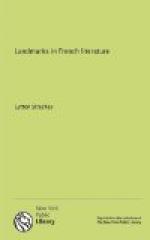The lines upon which the Romantic Movement was to develop had no connexion whatever with Chenier’s exquisite art. Throughout French Literature, it is easy to perceive two main impulses at work, which, between them, have inspired all the great masterpieces of the language. On the one hand, there is that positive spirit of searching and unmitigated common sense which has given French prose its peculiar distinction, which lies at the root of the wonderful critical powers of the nation, and which has produced that remarkable and persistent strain of Realism—of absolute fidelity to the naked truth—common to the earliest Fabliaux of the Middle Ages and the latest Parisian novel of to-day. On the other hand, there is in French literature a totally different—almost a contradictory—tendency, which is no less clearly marked and hardly less important—the tendency towards pure Rhetoric. This love of language for its own sake—of language artfully ordered, splendidly adorned, moving, swelling, irresistible—may be seen alike in the torrential sentences of Rabelais, in the sonorous periods of Bossuet, and in the passionate tirades of Corneille. With the great masters of the seventeenth century—Pascal, Racine, La Fontaine, La Bruyere—the two influences met, and achieved a perfect balance. In their work, the most penetrating realism is beautified and ennobled by all the resources of linguistic art, while the rhetorical instinct is preserved from pomposity and inflation by a supreme critical sense. With the eighteenth century, however, a change came. The age was a critical age—an age of prose and common sense; the rhetorical impulse faded away, to find expression only in melodramatic tragedy and dull verse; and the style of Voltaire, so brilliant and yet so colourless, so limited and yet so infinitely sensible, symbolized the literary character of the century. The Romantic Movement was an immense reaction against the realism which had come to such perfection in the acid prose of Voltaire. It was a reassertion of the rhetorical instinct in all its strength and in all its forms. There was no attempt simply to redress the balance; no wish to revive the studied perfection of the classical age. The realistic spirit was almost completely abandoned. The pendulum swung violently from one extreme to the other.




